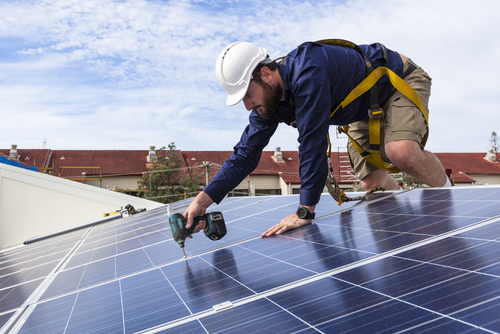Most utility executives are worried about customers leaving the grid, Accenture study finds

Many utility executives acknowledge a growing risk that the proliferation of distributed generation (DG) technologies like rooftop solar will cause a large number of electric customers to go off-grid in the near future, according to a recent study conducted by Accenture.
Conducted as part of Accenture’s 2018 Digitally Enabled Grid research program, the study found that 95 percent of the utility executives surveyed believe there is a risk that consumers will go largely off-grid within two years, using it only as an occasional backup.
“The rise in distributed renewables is not only impacting total electricity demand but also requires massive investments in new connections and grid reinforcement,” the report explained. “Traditional distribution efforts are also shifting as distributed energy resources (DER) proliferate, changing demand profiles including total demand reduction or stagnation, but without a commensurate decline in peak demand. Growing customer expectations mean distribution businesses must actively manage participation, such as in demand response, and provide network access to prosumers. Mass adoption of electric vehicles (EVs) is poised to alter demand growth and put pressure on grid stability.”
Accenture surveyed 150 utility C-suite and senior vice president-level executives from 25 countries.
Ninety-five percent of executives surveyed also said utilities are not able to keep up with grid capacity that new DG technologies, like rooftop solar, are bringing. Forty-eight percent of the respondents also said part of their grid will reach maximum capacity sometime in the next three years, and only 1 percent of respondents believe they won’t reach capacity for five years or more.
According to Accenture, residential and commercial consumers with rooftop solar may pass 15 percent of all consumers by 2036. Utility operations may be greatly affected by the shift, and it will be up to the utilities now if they identify how DG could cause local constraints on the distribution network.
In some markets, small-scale solar installations are growing at increasing speeds.
“For example, in Australia, as many as 15 percent of residential households owned a small-scale PV system in 2017,” the report said. “And, according to Accenture modeling, prosumer distributed generation has the potential to grow with equal rapidity in other countries, as seen by the nearly doubling of households with rooftop solar PV in Germany over 20 years; in California, the number of households could triple over the same period.”
Regulation in some areas has also helped DG in those regions grow even further. As an example, in California, PV installation will be required on new all new homes built in 2020 or after.
The utility executives ranked DG integration as their second-highest priority for future cost savings, with 59 percent choosing it in their top five choices. “Reducing supply chain unit costs through improved forecasting of materials and service requirements” was the No. 1 priority, with 61 percent choosing it as a priority.
“Distribution businesses have had a tough time in recent years with weak demand, which is one reason why grid operators’ profits have been squeezed,” said Stephanie Jamison, a managing director at Accenture who leads its Transmission and Distribution business. “The proliferation of DG changes electricity demand profiles, potentially diminishing total demand without necessarily reducing peak demand. Successful DG integration will require substantial investments in new connections and grid reinforcement to modernize the network and sustain the same level of reliability and safety and secure operations.”
While utilities are paying attention to the increase in DG, they are not all seeing it as a challenge. Ninety-five percent of respondents said DG and storage services will be a “major profit growth area” for distribution companies by 2025. Half of the executives also said that large-scale DG, grid-connected storage, small-scale prosumer DG, and community storage would be potential opportunities for their businesses going forward.
Accenture’s report also found that electricity demand will likely grow by 31 percent between 2026 and 2036, due in large part to the potential increases of both EV and building heating electrification. Accenture’s modeling found that the percentage of plug-in EVs could rise from 1 percent in 2019 to 3 percent in 2025, but could be as high as 37 percent by 2040.
Another factor that will have an effect on electricity demand will be the decarbonization of buildings, with 96 percent of the utility executives saying it will “substantially” reduce natural gas demand by 2040 in both residential and commercial buildings.
“However, to date there is no clear, practical plan for a transition to decarbonized buildings. In the short term, efforts will need to focus on energy-efficiency and conservation programs, using more efficient boilers and furnaces, improving building insulation, educating businesses and the public, and driving up the use of smart thermostats,” the report said. “Further ahead, more radical decarbonization will be needed, including the use of solar thermal and electric space and water heating that leverages renewables.”
Both factors could drive up peak demand consumption, according to Accenture’s modeling, which found an increase of 63 percent in demand during peak hours between 2016 and 2040.
“Mass adoption of electric vehicles and the electrification of building heating is poised to alter demand growth and load shape in the longer term,” Jamison said. “This suggests high growth potential for utility distributors, but it will also put pressure on grid stability. The key will be to navigate this disruption by making the grid more resilient through greater use of smart technologies and utilizing all sources of flexibility including on the demand side, adopting a more customer-centric approach.”
Accenture recommends that distribution energy providers need to “pivot” to the new way of energy, while also keeping a stable legacy business. Their largest challenge will be: “Scaling the new while driving the growth and efficiency of the core.”
To do this, the company recommends some ideas: Drive cost optimization, build a path to a new business model, build an innovation architecture, become relentlessly customer-centric, and invest in digital from periphery to core.
